
U.S. employment has increased steadily since the second quarter of 2020—the low point of the COVID-19 pandemic recession—adding more than 21 million jobs and growing at an average annual rate of 5.6 percent since that time.1 Alongside these employment gains is a perhaps lesser-known story: a string of declines in the average weekly hours worked of employees.2 This measure has fallen in six of the last seven quarters and has receded back to its level in the second quarter of 2020. This trend prompts the question: is it unusual for average weekly hours worked to decline while we experience sustained job growth? And what may be contributing to this trend?
This Beyond the Numbers article analyzes both recent and long-term declines in average weekly hours worked in the U.S. economy and identifies the retail trade industry and leisure and hospitality industry as the two most substantial contributors. The article further analyzes these declines in average weekly hours worked by placing them in the context of the COVID-19 pandemic and by observing how long-term shifts toward greater part-time employment and online shopping have impacted these industries. The effect of declining average weekly hours worked on labor productivity growth is also discussed.
Hours worked, employment, and average weekly hours worked
First, let us look at the recent paths of hours worked, employment, and average weekly hours worked in the private nonfarm sector.3 Hours worked are calculated as the product of employment and average weekly hours worked and represent the overall hours worked by all workers.4
Chart 1 shows that hours worked and employment have tracked each other closely throughout the recovery from the COVID-19 pandemic recession. As is typical in economic recoveries, employment is tracing an upward path from the low point of the recession, and these employment gains raise hours worked. However, while average weekly hours worked did initially increase slightly following the recession, this measure then drifted back to its starting level. Over the last seven quarters—the four quarters of 2022 and the first three quarters of 2023—average weekly hours worked have decreased 0.8 percent.5

Source: U.S. Bureau of Labor and Statistics
We should keep in mind that average weekly hours worked and employment are fundamentally different in certain respects. Employment exhibits two main characteristics: it trends upward as the U.S. population increases over time, and it often experiences large fluctuations during recessions and recoveries as layoffs and rehiring occur en masse. In contrast, average weekly hours worked are less volatile and have drifted downward over time. Chart 2 shows the path of average weekly hours worked over the last five business cycles. We see a general downward trend and the series stays within a range of between 32.5 and 35.0 average weekly hours worked during these four decades.6
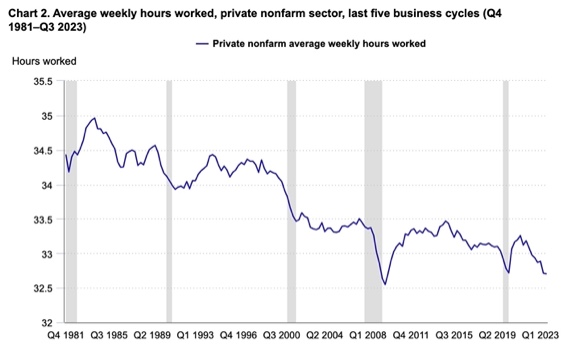
Source: U.S. Bureau of Labor and Statistics
In addition to the general downward trend in average weekly hours worked seen in chart 2, we notice that the largest downward movements in the measure tend to be associated with recessions. We see that average weekly hours worked declined in each of the last four recessions, and that the two largest declines occurred during the 2001 recession and the 2007–09 recession.
It does make sense that average weekly hours worked would decline during recessions, as employers desire to reduce their payroll expenses during these periods, and one way to do this is by reducing worker hours.7 Now, this leads to another question: if we can explain the notable drops in average weekly hours worked during recessions, what may cause the declines outside of recessions, such as those that occurred from 1984 to 1986, from 2015 to 2017, and most recently from 2021 to 2023? A deeper look at industry data may help us understand what may be driving the recent nonrecessionary decline in average weekly hours worked.
Industry contributions to the decline in economy-wide average weekly hours worked
Chart 3 shows the percentage-point contributions to the 0.8-percent decline in private nonfarm average weekly hours worked over the last 7 quarters from its 14 underlying industries. It is apparent that retail trade and leisure and hospitality make up a large part of the decline relative to the other 12 industries. These 2 industries together contribute over half of the 0.8-percent decline in average weekly hours worked, even though they make up just 20 percent of hours worked in the private nonfarm sector. Retail trade saw average weekly hours worked decline from 30.2 to 28.9 (2.5 percent) and leisure and hospitality declined from 26.2 to 25.2 (2.1 percent) over the period.
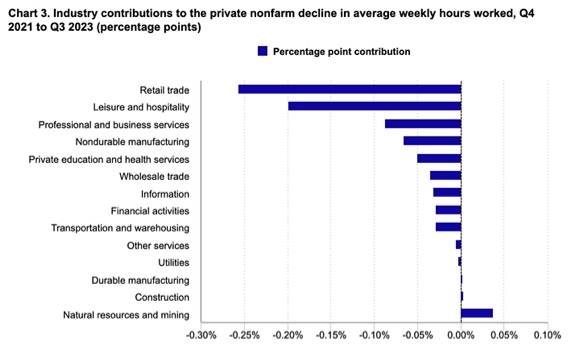
Source: U.S. Bureau of Labor and Statistics
In the context of the current business cycle, it makes sense that we would see a decrease in average weekly hours worked in these two industries, as they faced decreased demand for their services as some consumers reduced visits to restaurants, bars, and retail stores as a result of the COVID-19 pandemic. The pandemic also accelerated the migration to online shopping, a trend that has been reshaping the retail trade industry and affecting its labor market in recent decades.8
Some weakness in the leisure and hospitality and retail trade industries may also be exhibited by their employment record in the current business cycle. Despite notable increases in employment in these 2 industries since the low point of the COVID-19 pandemic in the second quarter of 2020, the industries recorded the second and fourth lowest employment changes since the fourth quarter of 2019 among the 14 industries, respectively. The leisure and hospitality industry still has a deficit of 67,000 jobs, and retail trade has added just 9,000 jobs, relative to the fourth quarter of 2019. This may indicate some continued weakness relative to the prepandemic period, especially when paired with their accompanying declines in average weekly hours worked.
What contributed to the declines in average weekly hours worked in retail trade and leisure and hospitality?
We can also look at more detailed industry data to see which of the industries in retail trade and leisure and hospitality have most contributed to their declines in average weekly hours worked over the last seven quarters.9
Chart 4 indicates that the most substantial industry contributor to the 2.4-percent decline in retail trade average weekly hours worked is the general merchandise stores industry, with a contribution of −0.90 percentage points. Food and beverage stores and clothing and clothing accessories stores contributed −0.44 and −0.30 percentage points, respectively.
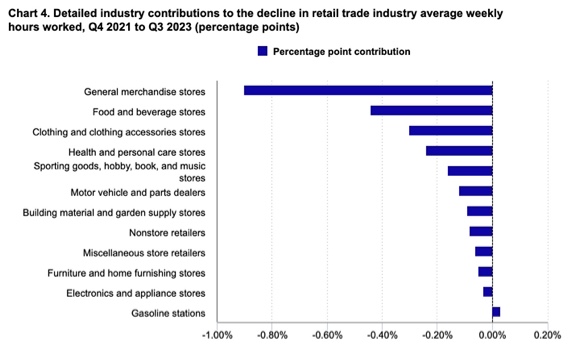
Source: U.S. Bureau of Labor and Statistics
As we see in chart 5, the largest contributor to the 2.1-percent decline in average weekly hours worked in leisure and hospitality is the food services and drinking places industry, with a contribution of −1.49 percentage points. Amusements, gambling, and recreation and performing arts and spectator sports contributed −0.39 and −0.20 percentage points, respectively.
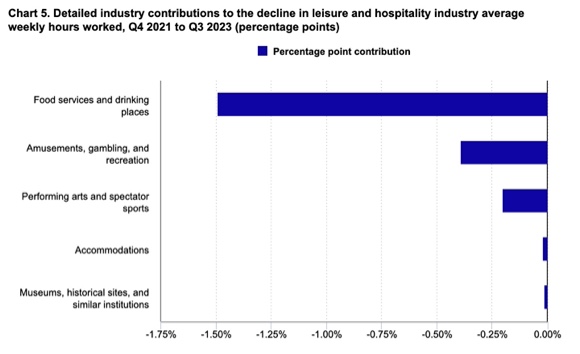
Source: U.S. Bureau of Labor and Statistics
It is notable that, in addition to the recent declines in average weekly hours worked in retail trade and leisure and hospitality, there were also declines in most of the other private sector industries. Eleven of the 14 industries in chart 3 saw declines in average weekly hours worked, with only natural resources and mining posting a substantial gain (3.5 percent) over the last 7 quarters. So, while retail trade and leisure and hospitality had the largest recent declines in average weekly hours worked, it appears that there has been a broader trend toward slightly reduced average weekly hours worked throughout most industries of the U.S. economy.
How did the decline in average weekly hours worked affect labor productivity?
The recent declines in average weekly hours worked have affected the BLS labor productivity series, defined as output per hour worked. BLS uses hours worked as the labor input series in estimating labor productivity—rather than employment—because this series provides a fuller representation of the overall labor contribution of workers in each quarter, as it reflects changes in employment as well as changes in these workers’ average weekly hours worked.
While labor productivity data users are familiar with output per hour worked, there is also a lesser-known productivity measure—output per worker—that offers us another perspective on productivity over a given period, by showing changes in output relative to changes in employment—also a widely tracked measure of labor growth. Just as with labor productivity, output per worker increases whenever the amount of goods and services produced rises faster than the amount of labor engaged in producing it. However, in the case of output per worker, that labor amount is recorded as the number of workers engaged in production rather than the number of hours they worked.
Chart 6 shows the paths that labor productivity (output per hour worked) and output per worker have taken in the current business cycle (Q4 2019 to Q3 2023). The gaps between these two measures in the early and latter portions of this chart—when labor productivity outpaced output per worker—represent the effect of declining average weekly hours worked during these periods.
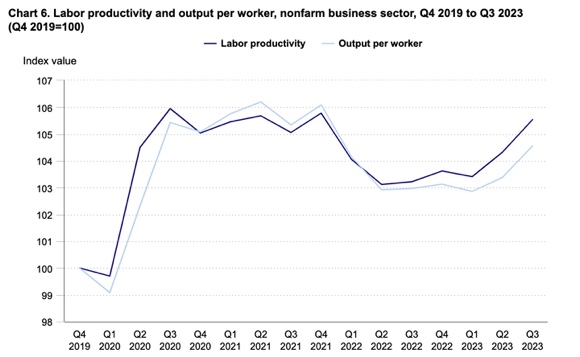
Source: U.S. Bureau of Labor and Statistics
We know that declining average weekly hours worked are responsible for the gaps between these two measures because average weekly hours worked is the sole difference between them; labor productivity takes this measure into account, whereas output per worker does not. The fact that labor productivity grew faster than output per worker in these periods indicates that production was more efficient per hour worked than it was per worker.
Over the current business cycle (Q4 2019 to Q3 2023), labor productivity has grown 1.4 percent, which is more than output per worker, which grew 1.2 percent. And over the last seven quarters—which encompasses the recent declines in average weekly hours worked—labor productivity decreased 0.1 percent, while output per worker decreased 0.8 percent.
So, we can see that the declines in average weekly hours worked during the current business cycle have supported labor productivity growth during this period, and that without these declines (that is, if our productivity measure were based on employment alone, without accounting for average weekly hours worked), the measure would have been even lower than the below-average rate we have reported. The published rate of labor productivity growth during the current business cycle (1.4 percent) is below both the rate of the last cycle (1.5 percent) and the long-term rate since 1947 (2.1 percent), though it is higher than the current-cycle output per worker increase of 1.2 percent.
A difference of 0.2 percentage points between labor productivity growth and output per worker growth over the course of a business cycle is nontrivial, and this indicates that the contribution to productivity growth from average weekly hours worked is worth monitoring to observe how it is affecting the top-line labor productivity estimate over time.10
Examining the long-term decline in average weekly hours worked
Recalling chart 2, we might also wonder what industries contributed most to the long-term decline in average weekly hours worked over the last five business cycles. Was this similar to or different from what we have observed during the last seven quarters?
From the third quarter of 1981 to the third quarter of 2023, the retail trade and leisure and hospitality industries made the largest contributions to the long-term decline in average weekly hours worked, just as they did over the last seven quarters. As shown in chart 7, retail trade contributed 0.04 percentage points to the 0.12-percent decline in private nonfarm average weekly hours worked over this long-term period, falling from 32.6 to 28.9 average weekly hours worked. Leisure and hospitality contributed 0.02 percentage points to the decline, falling from 27.2 to 25.2 average weekly hours worked.
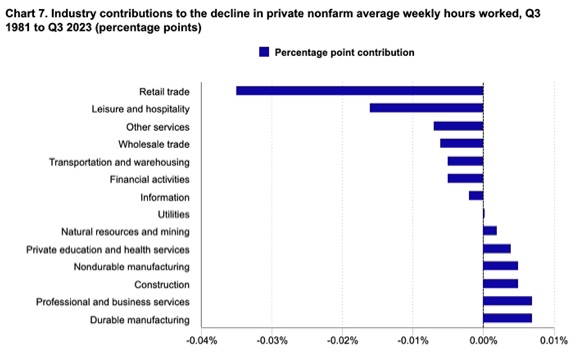
Source: U.S. Bureau of Labor and Statistics
One of the reasons for the long-term decline in average weekly hours worked in these two industries might be increases in part-time employment during portions of this period. Given the lower average weekly hours worked associated with part-time workers, increased hiring of these workers can contribute to declines in industry average weekly hours worked.
During the two decades preceding 2000, increased need for part-time workers in retail trade came in part from the repeal of the Blue Laws that had restricted certain businesses from being open on certain days, such as Sundays or religious holidays, in many states. These repeals may underlie some of the decline in average weekly hours worked during the 1980s. The rise of shopping malls in the 1980s and 1990s, with stores that were open longer hours, also encouraged the hiring of more part-time workers11. And in leisure and hospitality, increased demand for eating and drinking places led employers to hire more part-time workers including students, retired persons, and workers wanting a second job.12
The trend toward increased part-time employment in these industries has continued since 2000, as part-time employment rose 0.2 percent in wholesale and retail trade and 1.3 percent in leisure and hospitality. These rates were higher than employment changes for full-time workers in these industries, which were unchanged in wholesale and retail trade and increased 0.9 percent in leisure and hospitality.13
Conclusion
The retail trade industry and the leisure and hospitality industry were the major contributors to declines in U.S. average weekly hours worked over the last seven quarters and over the last four decades. The declines in this measure in these two industries during the current business cycle reflected lingering effects of the COVID-19 pandemic, and during the last four decades were related to the long-term increases in part-time employment.
The economy-wide declines in average weekly hours worked during these periods boosted rates of labor productivity (output per hour worked) growth above the rate of output per worker growth. Further, the intermittent gains and declines in the U.S. average weekly hours worked series that we have observed over the last four decades—during recessions and expansions—indicate that this series will be worthwhile to track so we can monitor its effect on labor productivity growth in the future.
Article Courtesy: U.S. Bureau of Labor and Statistics
NOTES
- Unless otherwise specified, all percent changes in this article are average annual rates of change. Data in this article are as of November 2, 2023. Data on employment and hours worked for the private nonfarm sector are produced by the BLS Office of Productivity and Technology (OPT), primarily using data on employment and hours paid for private industries from the BLS Current Establishment Statistics (CES) program, and making several adjustments for coverage and concept differences, including using other BLS data to convert hours paid to an hours worked concept. The private nonfarm sector excludes government establishments and the farm sector.
“A New Methodology for Estimating Hours Worked for U.S. Labor Productivity Measurement,” U.S. Bureau of Labor Statistics, accessed March 19, 2024, https://www.bls.gov/productivity/technical-notes/labor-productivity-hours-worked-method-using-ces-all-employee-hours-nov-2022.htm.
The CES program, which provides detailed industry data on employment, hours, and earnings of workers on nonfarm payrolls, is a monthly survey of about 122,000 businesses and government agencies representing approximately 666,000 individual worksites.
“A New Methodology for Estimating Hours Worked for U.S. Labor Productivity Measurement,” U.S. Bureau of Labor Statistics, accessed March 19, 2024, https://www.bls.gov/productivity/technical-notes/labor-productivity-hours-worked-method-using-ces-all-employee-hours-nov-2022.htm. - Average weekly hours worked, produced by OPT, estimates the hours for which employees are at work, which differs from the average weekly hours paid data produced by the CES program, which counts all hours for which employees are paid.
- Private nonfarm hours worked are the main component used in estimating the nonfarm business labor hours that are used in estimating nonfarm business output per hour, or labor productivity. We are analyzing the private nonfarm sector here because it both supplies the bulk of the hours used in estimating productivity and can also be easily decomposed into its industry-level contributions.
- To present the hours worked measure on an annualized-level basis, and to present the measure in billions rather than millions, OPT also multiplies this product by constant factors of 52 and .001. Monthly, quarterly, and annual hours worked levels are all presented on an annualized-level basis, for comparability.
- Unless otherwise specified, all percent changes in this article are average annual rates of change.
- The cyclical peak quarter in 1981 was the third quarter. Chart 2 begins with the fourth quarter of 1981 as this was the first quarter of the recessionary period of that cycle, representing the first quarter of that cycle. Also, although average weekly hours worked have declined in the United States over time, it is notable that U.S. workers still have higher average working hours relative to workers of other nations.
Alexander Bick, Adam Blandin, and Nicola Fuchs-Schündeln, “Reassessing economic constraints: Maximum employment or maximum hours?”(Handout prepared for the 2022 Jackson Hole Economic Policy Symposium, August 26, 2022), https://www.kansascityfed.org/Jackson%20Hole/documents/9024/F1.BBF_jackson_hole_handout.pdf.
Dain Lee, Jinhyeok Park, and Yongseok Shin, “Where are the workers? From great resignation to quiet quitting,” Working Paper 30833 (Cambridge, MA: National Bureau of Economic Research, January 2023), 15.
Business cycle dates are defined by the National Bureau of Economic Research (NBER), and are presented at the NBER page “US Business Cycle Expansions and Contractions”: https://www.nber.org/research/data/us-business-cycle-expansions-and-contractions. - Philip L. Rones, “Response to recession: reduce hours or jobs?” Monthly Labor Review, U.S. Bureau of Labor Statistics (October 1981), https://www.bls.gov/opub/mlr/1981/10/art1full.pdf.
- Grace Dean, “Understaffed restaurants are being forced to choose between closing earlier and shutting their dining rooms,” Business Insider, (October 23, 2021), https://www.businessinsider.com/labor-shortage-restaurants-close-earlier-opening-times-shut-dining-rooms-2021-10.
Alicia Kelso, “BLS: Hospitality worker quit rate is more than double national average,” Restaurant Dive, (October 13, 2021), https://www.restaurantdive.com/news/bls-hospitality-worker-quit-rate-is-more-than-double-national-average/608112/.
The relatively low employment growth in the retail trade industry in recent years reflects both the effect of the COVID-19 pandemic as well as pre-existing declines due to the rise of e-commerce.
Daniel Dorfman, “Retail trade employment: before, during, and after the pandemic,” Beyond The Numbers: Employment & Unemployment 11, no. 4, U.S. Bureau of Labor Statistics (April 2022), https://www.bls.gov/opub/btn/volume-11/retail-trade-employment-before-during-and-after-the-pandemic.htm. - In addition to the 3-digit NAICS industry data shown in Charts 4 and 5, OPT also publishes data at greater industry detail, which can be found here: https://www.bls.gov/productivity/tables/labor-productivity-detailed-industries.xlsx. Note that all NAICS classifications used in this article are for NAICS 2017, not NAICS 2022, because the output data necessary for productivity measurement has not yet transitioned to NAICS 2022. CES, which provides data to OPT, has transitioned to NAICS 2022:
“Notice of Publication Changes with the Release of Data on February 3, 2023," last modified on February 3, 2023, https://www.bls.gov/ces/notices/2023/2023-bmk-series-changes.htm. - BLS also publishes productivity measures for retail trade: U.S. Bureau of Labor Statistics, Economic News Release, Productivity and Costs by Industry: Wholesale Trade and Retail Trade Industries – 2022, (May 25, 2023), https://www.bls.gov/news.release/archives/prin1_05252023.htm.
and food service:
U.S. Bureau of Labor Statistics, Economic News Release, Productivity and Costs by Industry: Selected Service-Providing Industries – 2022,(June 29,2023), https://www.bls.gov/news.release/archives/prin2_06292023.htm. - Katie Kirkland, “On the decline in average weekly hours worked,” Monthly Labor Review, U.S. Bureau of Labor Statistics (July 2000), 28, https://www.bls.gov/opub/mlr/2000/07/art3full.pdf.
- Kirkland, “On the decline in average weekly hours worked,” 28.
- These rates are from September 2000 to September 2023; wholesale trade and retail trade were used in this case, rather than retail trade, as data for retail trade by itself was not available online for these series.